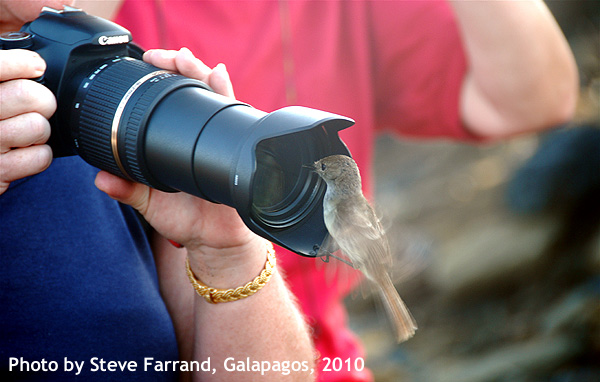 Yesterday a good friend reminded me how much of my skills I’ve lost. As I approach my 50th year as a professional safari guide the horrors of sentimentality led to outright embarrassment: it’s not really my age, it’s Alexa.
Yesterday a good friend reminded me how much of my skills I’ve lost. As I approach my 50th year as a professional safari guide the horrors of sentimentality led to outright embarrassment: it’s not really my age, it’s Alexa.Read more
 Yesterday a good friend reminded me how much of my skills I’ve lost. As I approach my 50th year as a professional safari guide the horrors of sentimentality led to outright embarrassment: it’s not really my age, it’s Alexa.
Yesterday a good friend reminded me how much of my skills I’ve lost. As I approach my 50th year as a professional safari guide the horrors of sentimentality led to outright embarrassment: it’s not really my age, it’s Alexa.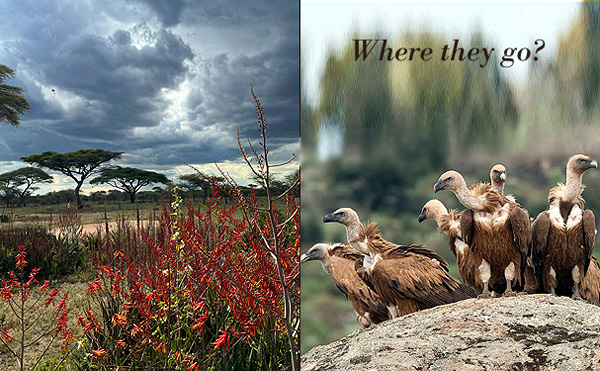 Hundreds of vultures. Mounted on the acacia trees, flying between the patches of thick forest, landing and taking off from the meadows within the woods. So we plowed back and forth through the high grasses trying to discover what they were scavenging. What dinosaur could bring so many birds together?
Hundreds of vultures. Mounted on the acacia trees, flying between the patches of thick forest, landing and taking off from the meadows within the woods. So we plowed back and forth through the high grasses trying to discover what they were scavenging. What dinosaur could bring so many birds together?
Radioing back and forth between our rovers we covered almost every inch of open ground and could find nothing, even as the shadows of their huge wings slipped back and forth across us. What was going on?
Read more
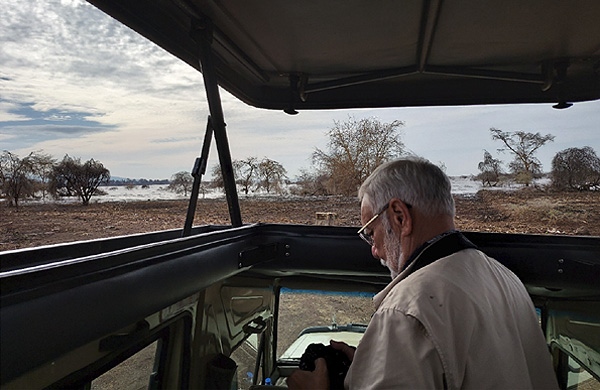 The menacing sky peeking through the opened roof above Steve in the land cruiser said it all. Those stringy clouds at 7:30 in the morning foretell a massive thunderstorm this afternoon. Yesterday afternoon we had the most extraordinary thunder imaginable, as if you were in the gods’ bowling alley during a weekend tournament.
The menacing sky peeking through the opened roof above Steve in the land cruiser said it all. Those stringy clouds at 7:30 in the morning foretell a massive thunderstorm this afternoon. Yesterday afternoon we had the most extraordinary thunder imaginable, as if you were in the gods’ bowling alley during a weekend tournament.
It’s Day 3 OnSafari and we’re in Lake Manyara National Park. When the rains just begin it’s so dry below and the cumulus storm clouds so large and high above that much of the water never reaches the ground. It takes several days of saturating the atmosphere before the waterfall begins.
Read more
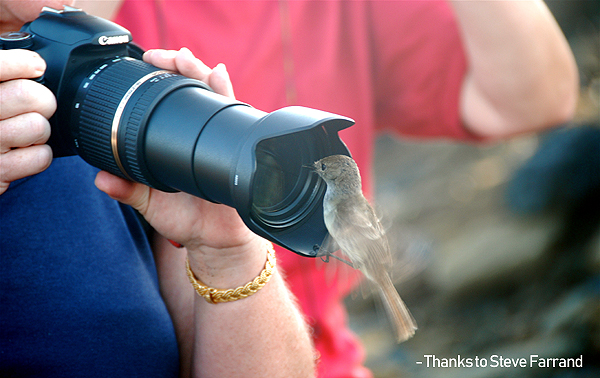 Today I assist our area’s most celebrated birder in conducting the “BBS” for our government. The Breeding Bird Survey gives me a great perspective when comparing African avifauna to the bird life of my home.
Today I assist our area’s most celebrated birder in conducting the “BBS” for our government. The Breeding Bird Survey gives me a great perspective when comparing African avifauna to the bird life of my home.
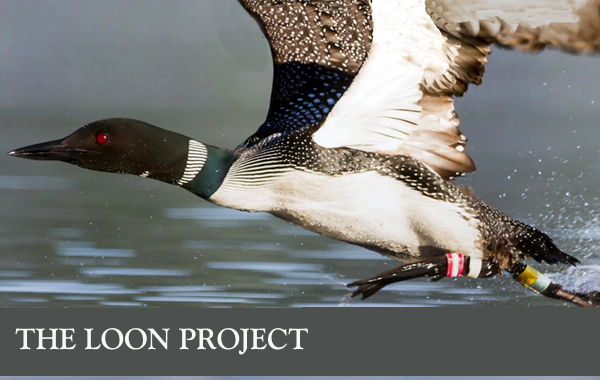 I was sitting in our breakfast room, the corner of the house all windowed, overlooking the lake when a red Corolla with a red canoe on top raced down our driveway and a tall lanky man with wading boots and a funny hat jumped out and ran to the edge of the lake.
I was sitting in our breakfast room, the corner of the house all windowed, overlooking the lake when a red Corolla with a red canoe on top raced down our driveway and a tall lanky man with wading boots and a funny hat jumped out and ran to the edge of the lake.
When he raised his binoculars my concern turned to relief. I walked out barefoot in my jammies into the 45F spectacularly clear morning and introduced myself, but I all I did was manage to agitate him as he muttered, “Yellow over red. No… pink over red.”
 Today I join thousands of other Americans in the “Christmas Bird Count.” (It’s time to change the name to something more secular).
Today I join thousands of other Americans in the “Christmas Bird Count.” (It’s time to change the name to something more secular).
Volunteers across the country survey their regions for what birds remain after the annual fall migration. Since Christmas Day 1900, the bird count has proceeded uninterrupted by wars or depressions.
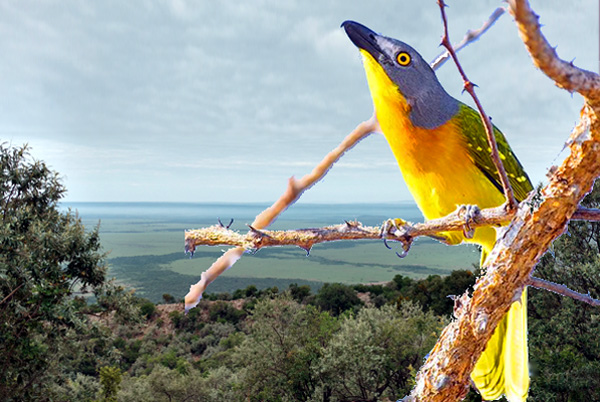 Ole Kisemei took me to the highest point in the Mara this morning, Kileleoni. The view was magnificent, but what we saw going up and down was even better.
Ole Kisemei took me to the highest point in the Mara this morning, Kileleoni. The view was magnificent, but what we saw going up and down was even better.
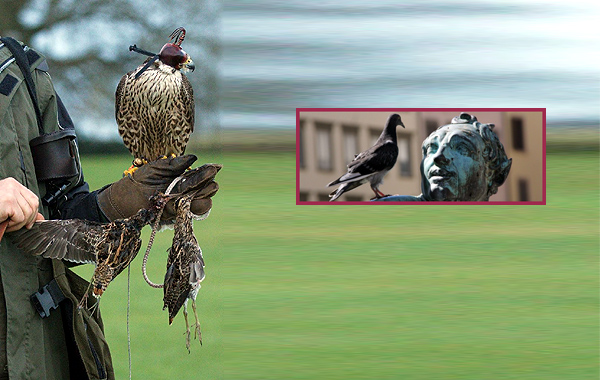 Sports that kill, and oh by the way eradiction of so-called invasive species, are hardly my cups of tea, but what do you think might soften my aversions? How about falconry clearing pigeons from monuments?
Sports that kill, and oh by the way eradiction of so-called invasive species, are hardly my cups of tea, but what do you think might soften my aversions? How about falconry clearing pigeons from monuments?
 Less pain now let’s you choose a better burger for that last meal! Your puppy Fido will be all better in time for the apocalypse! Cataract surgery for vampires!
Less pain now let’s you choose a better burger for that last meal! Your puppy Fido will be all better in time for the apocalypse! Cataract surgery for vampires!
Vultures are in trouble, real trouble. More than half the species worldwide are going extinct. The main reason is a popular Novartis drug, diclofenac.
 So maybe our tea is OK, but Carbofuran is still for sale over the counter in Kenya: Lions are being poisoned with it, vultures picking on the carcasses are going extinct, and so human diseases are spreading and there’s an epidemic of rabies among the growing population of feral dogs.
So maybe our tea is OK, but Carbofuran is still for sale over the counter in Kenya: Lions are being poisoned with it, vultures picking on the carcasses are going extinct, and so human diseases are spreading and there’s an epidemic of rabies among the growing population of feral dogs.
Nature’s complicated.
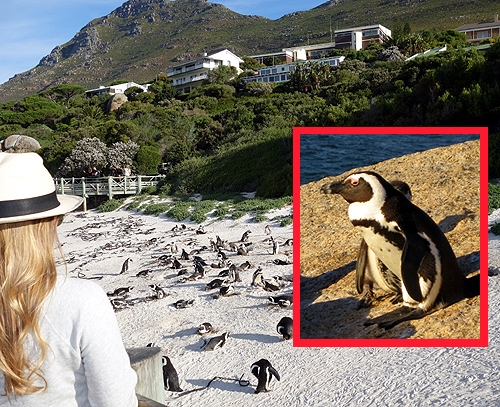 Human/wildlife conflict isn’t limited to dangerously powerful elephants walking over an impoverished Tanzanian farmer’s watermelon field. Several days ago in a thoroughly modern city in The Cape one of the world’s most endangered animals suffered a serious blow from … car traffic.
Human/wildlife conflict isn’t limited to dangerously powerful elephants walking over an impoverished Tanzanian farmer’s watermelon field. Several days ago in a thoroughly modern city in The Cape one of the world’s most endangered animals suffered a serious blow from … car traffic.
There are few animals in the world as endangered as the African Penguin (Spheniscus demersus), sometimes called the Jackass penguin. Just over 25,000 breeding pairs remain of a sustainable population of 1.2 million birds that existed only a half century ago.
This is a far greater catastrophic decline than that of elephants or lions, and it shows no sign of abating.
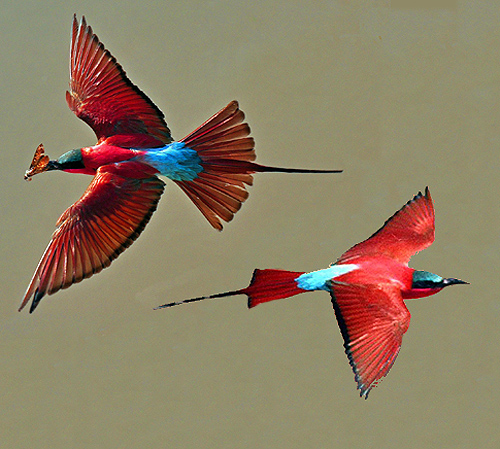 In North America we’re currently documenting the fascinating “Spring Migration.” Almost 4,000 birds fly up here to breed as spring begins.
In North America we’re currently documenting the fascinating “Spring Migration.” Almost 4,000 birds fly up here to breed as spring begins.
Two months ago I was in Africa documenting a different migration. Of all the birds I’ve watched going and coming in both hemispheres of the world, one story really stands out: Africa’s carmine bee-eater.
This “migrant” makes three separate migrations, changing its direction three separate times and it tells us probably more about long-term climate change than any bird in the world.
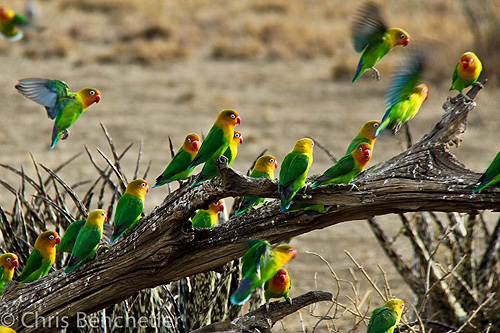 You might think these are parakeets in the Amazon, but they aren’t! They’re Fisher’s Lovebirds coming down to water within ten feet of the dining table at Ndutu Lodge in the southwest Serengeti! This beautiful picture was taken in September, 2011, by Chris Benchetler on one of my guided safaris, as part of my collection of favorite photos from my safaris over the last 39 years. Come back here on July 23 as I begin guiding my last safari of the season in Tanzania.
You might think these are parakeets in the Amazon, but they aren’t! They’re Fisher’s Lovebirds coming down to water within ten feet of the dining table at Ndutu Lodge in the southwest Serengeti! This beautiful picture was taken in September, 2011, by Chris Benchetler on one of my guided safaris, as part of my collection of favorite photos from my safaris over the last 39 years. Come back here on July 23 as I begin guiding my last safari of the season in Tanzania.